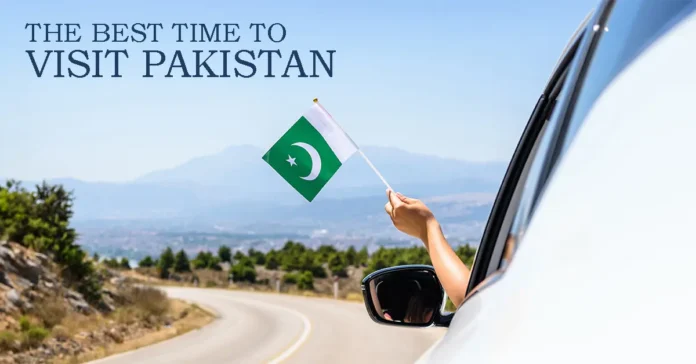Pakistan is one of the most beautiful and diverse travel destinations in South Asia. From the snow-covered peaks of the north to the rich history and culture of its cities, there’s so much to explore. But to enjoy your trip fully, it’s important to choose the best time to visit Pakistan.
The country has a wide range of weather conditions depending on the season and region. Some areas become too hot in summer, while others are not accessible in winter due to snowfall. That’s why planning your trip at the right time helps you avoid weather issues and enjoy every moment of your journey.
Whether you’re a nature lover, an adventure seeker, or someone interested in culture and history, knowing the best time to visit Pakistan will help you make the most of your experience.
If you’re planning your trip, don’t miss our guide on the 10 best places to visit in Pakistan for breathtaking views and unforgettable experiences
Why Timing Matters for Your Pakistan Trip

Pakistan has a very diverse climate. The country includes mountain regions, green valleys, deserts, and coastal areas. Each part of Pakistan experiences different weather at different times of the year. That’s why timing is so important when planning your trip.
If you travel at the wrong time, you might face road closures, extreme heat, or even flight delays. For example, the northern areas often receive heavy snowfall in winter, which makes travel difficult. In contrast, the southern regions can become extremely hot in the summer months.
The best time to visit Pakistan also depends on what you want to do. Some seasons are perfect for hiking and sightseeing. Others are great for enjoying festivals or cultural events. By choosing the right time, you’ll have a safer, more comfortable, and more enjoyable experience.
Best Time to Visit Pakistan by Season
The best time to visit Pakistan depends on the season and the region you plan to explore. Each season offers something unique, whether it’s colorful landscapes, pleasant weather, or outdoor activities. Here’s a simple guide to help you understand what each season brings.
Spring (March to May)
Spring is one of the most pleasant times to visit Pakistan. The weather is mild, flowers are in full bloom, and the landscapes are vibrant and green. This is a great season for sightseeing, nature walks, and exploring cities and valleys.
You can enjoy places like Hunza, Swat, and Lahore during this time. Spring is also when many local festivals take place, giving travelers a chance to experience the rich culture of the country.
Summer (June to August)
Summer is perfect for those who want to explore the northern areas. The high-altitude regions like Skardu, Fairy Meadows, and Naran Kaghan become accessible after the snow melts. The weather in these areas is cool and refreshing compared to the hot temperatures in the south.
However, cities like Lahore, Islamabad, and Karachi can get very hot in summer. If you plan to visit those, be prepared for high temperatures and humidity.
Autumn (September to November)
Autumn is another great season to visit Pakistan. The weather is pleasant, and the crowds are fewer. In northern regions like Hunza, the trees turn golden and red, creating stunning views that are perfect for photography.
Autumn is also a good time for hiking, as the trails are dry and the temperatures are moderate. It’s a peaceful and colorful time to explore the natural beauty of Pakistan.
Winter (December to February)
Winter is ideal for those who enjoy snow and winter sports. Popular spots like Murree, Malam Jabba, and parts of Skardu offer skiing and snowboarding. The scenery in the mountains becomes magical during snowfall.
At the same time, winter is the best time to visit southern Pakistan. Cities like Karachi, Multan, and Hyderabad have mild temperatures, making them comfortable for sightseeing and cultural tours.
Regional Weather Guide for Tourists

Pakistan’s geography is incredibly diverse, and so is its weather. While one region may be freezing cold, another might be warm and sunny. Here’s a simple guide to help you understand when to visit each major region of Pakistan.
Northern Pakistan
Northern Pakistan is known for its breathtaking mountains, valleys, and lakes. Areas like Gilgit-Baltistan, Hunza, Swat, Chitral, and Skardu are popular with nature lovers and adventure travelers.
The best time to visit the north is from May to October. During these months, the weather is pleasant, and most roads and trekking routes are open. Winter months can bring heavy snowfall, which may block roads and make travel difficult.
Central Pakistan
Central Pakistan includes cities like Lahore, Islamabad, Faisalabad, and Peshawar. These areas have four clear seasons and a mix of urban and natural attractions.
The best time to visit this region is during spring (March to May) and autumn (September to November). The weather is mild, and the air is clearer. Summers can be very hot, especially in cities like Faisalabad. Winters are cold but generally manageable for sightseeing.
Southern Pakistan
Southern Pakistan includes cities like Karachi, Hyderabad, and interior Sindh. This region has a hot desert climate and doesn’t experience snowfall.
The best time to visit the south is from November to February, when temperatures are much cooler. During summer, the heat can be extreme, especially inland. Karachi, being a coastal city, remains humid year-round but is more bearable in winter.
Best Time to Visit Pakistan for Different Travelers
Every traveler is different. Some want to hike in the mountains, while others prefer learning about local cultures or relaxing in peaceful valleys. Pakistan offers something for everyone, and the best time to visit depends on what kind of trip you’re looking for.
Nature and Landscape Lovers
If you love nature, green fields, and colorful views, then spring (March to May) and autumn (September to November) are the perfect seasons for you. The weather is pleasant, flowers bloom in spring, and the trees change color in autumn. These months are ideal for photography, nature walks, and quiet moments in the valleys of Hunza, Swat, and Fairy Meadows.
Adventure Seekers and Hikers
For adventure travelers, summer (June to August) is the best time to visit the northern mountains. The snow melts, and trekking routes open up in areas like Skardu, Naran, and Chitral. You can hike, camp, and even climb some of the world’s tallest peaks. The weather is cool and comfortable in these high-altitude places during summer.
Cultural Travelers
If you’re interested in exploring Pakistan’s rich culture, architecture, and history, spring and winter are great times to visit. Cities like Lahore, Islamabad, Multan, and Peshawar are full of historical landmarks, museums, and local markets. Spring brings festivals like Basant, while winter offers pleasant weather for city tours and cultural events.
Festivals and Events to Consider
Pakistan is a country full of colors, traditions, and celebrations. Attending a local festival is a great way to experience the culture and connect with people. If you plan your trip around these events, it can make your visit even more memorable.
Basant (Spring Festival)
Basant is celebrated in cities like Lahore to mark the beginning of spring. People fly colorful kites, enjoy traditional foods, and gather on rooftops. It usually takes place in late February or early March. It’s a fun and energetic time to visit.
Independence Day (August 14)
This is a national holiday celebrated across the country. Streets, buildings, and vehicles are decorated with flags. Parades, fireworks, and music events are common, especially in big cities. It’s a great day to see national pride and energy.
Shandur Polo Festival (July)
Held in Gilgit-Baltistan, this is one of the highest polo grounds in the world. Teams from Chitral and Gilgit face off in a traditional match, and the event includes music, dance, and camping under the stars. It’s a unique cultural and adventure experience combined.
Chilam Joshi Festival (May)
This is a traditional festival of the Kalash people in Chitral. It celebrates the arrival of spring with dancing, singing, and rituals. It gives travelers a rare chance to see the lifestyle of one of Pakistan’s smallest and oldest communities.
Religious Festivals (Eid al-Fitr, Eid al-Adha, and Ramadan)
These Islamic holidays are widely observed. During Eid, families gather, wear traditional clothes, and enjoy special meals. While some businesses close during these days, it’s still a good time to experience local hospitality and cultural traditions.
Month-by-Month Breakdown
Here’s a quick guide that shows what to expect in each month of the year. This will help you decide the best time to visit Pakistan based on weather, activities, and travel goals.
January
- Cold in most regions, especially the north.
- Ideal for snow lovers and winter sports in Murree, Malam Jabba, and Skardu.
- Great weather in southern cities like Karachi and Hyderabad.
February
- Snow continues in the north.
- Weather starts getting mild in central Pakistan.
- Good time for visiting Lahore and Islamabad before spring begins.
March
- Beginning of spring.
- Flowers start blooming in valleys and cities.
- Perfect time to explore gardens, parks, and historical sites.
April
- Ideal spring weather across the country.
- Best time to visit cultural cities like Lahore and Peshawar.
- Northern areas begin to thaw, making them more accessible.
May
- Still good weather in the north and center.
- A bit warm in southern regions.
- Best time for Chilam Joshi Festival in Chitral.
June
- Start of summer and the best time for mountain travel.
- Great for hiking and trekking in Hunza, Naran, and Skardu.
- Hot in central and southern Pakistan.
July
- Peak summer in the mountains — perfect for adventure lovers.
- Shandur Polo Festival is held this month.
- Avoid southern Pakistan due to extreme heat.
August
- Good for exploring northern areas.
- Monsoon rains may affect some regions.
- Independence Day celebrations across the country.
September
- Start of autumn — cooler weather in the north.
- Beautiful fall colors begin to appear in places like Hunza.
- Fewer tourists, so it’s quieter and more peaceful.
October
- One of the best months for photography and hiking.
- Autumn views at their peak in Gilgit-Baltistan.
- Pleasant weather in central Pakistan too.
November
- Cooler days, especially in the north.
- Great time for cultural trips and city exploration.
- Ideal month for visiting central and southern regions.
December
- Snow returns to the mountains.
- Best time for winter lovers.
- Karachi and other southern cities offer mild and pleasant weather.
Final Tips for Planning Your Trip

To make your journey smooth and enjoyable, here are a few simple tips to keep in mind when deciding on the best time to visit Pakistan.
1. Check Weather Updates Before You Travel
Weather in some regions can change quickly, especially in the mountains. Always check the forecast before your trip, and be flexible with your plans if needed.
2. Pack According to the Season
If you’re visiting in winter, bring warm clothes, especially for the north. In summer, light and breathable clothing is best. Don’t forget sunscreen and a hat for sunny days.
3. Avoid Public Holidays for Quieter Travel
During major holidays like Eid, transport can be crowded and some businesses may close. If you prefer quiet travel, try visiting just before or after these dates.
4. Book Accommodation in Advance
During peak seasons like summer in the north or spring in cities, hotels can fill up fast. Booking early can save you time, money, and stress.
5. Respect Local Culture and Traditions
Pakistan is a culturally rich and traditional country. Dress modestly, follow local customs, and always ask before taking photos of people or religious places.
Pakistan is a land of natural beauty, rich history, and warm hospitality. But to enjoy everything it has to offer, choosing the best time to visit Pakistan is key. Whether you want to hike in the mountains, explore historic cities, or take part in local festivals, each season brings its own charm.
Spring and autumn are perfect for sightseeing and cultural tours, while summer opens up the majestic north for adventure seekers. Winter is ideal for snow lovers and for exploring the southern regions in comfort. By understanding the seasons and planning ahead, you can make your trip truly memorable and stress-free.
No matter when you decide to visit, Pakistan will welcome you with open arms and unforgettable experiences.
“Always check the forecast on trusted sources like the Pakistan Meteorological Department before finalizing your travel plans.”
Conclusion
Pakistan is a land of natural beauty, rich history, and warm hospitality. But to enjoy everything it has to offer, choosing the best time to visit Pakistan is key. Whether you want to hike in the mountains, explore historic cities, or take part in local festivals, each season brings its own charm.
Spring and autumn are perfect for sightseeing and cultural tours, while summer opens up the majestic north for adventure seekers. Winter is ideal for snow lovers and for exploring the southern regions in comfort. By understanding the seasons and planning ahead, you can make your trip truly memorable and stress-free.
No matter when you decide to visit, Pakistan will welcome you with open arms and unforgettable experiences.

